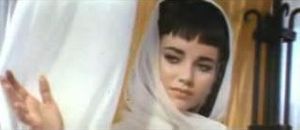Dance of the Seven Veils
In several notable works of Western culture, the Dance of the Seven Veils (usually described as danced by Salomé) is one of the elaborations on the historical and Bible|biblical tale of the execution of John the Baptist.
Biblical account
According to ten verses of Gospel of Matthew 14, John was imprisoned for criticizing King Herod Antipas' marriage to Herodias, the former wife of Antipas' "brother" Herod Philip I. Herod offered his niece a reward of her choice for performing a dance on his birthday. Herodias persuaded her daughter to ask for John the Baptist's head on a platter. Against his better judgment, Antipas reluctantly acceded to her request.
Account by Flavius Josephus
The historian Josephus lists the stepdaughter's name as Salomé and provides other details enriching the story in later Christian legend. He provides a name for the dance and states that the purpose of the dance was to inflame Herod with incestuous desire, thereby inducing him to grant her wish for John's death.
Possible origin in myths
The Dance of the Seven Veils is also thought to have originated with the myth of the goddess Ishtar and the god Tammuz of Assyrian and Babylonian lore. In this myth, after Ishtar's lover Tammuz dies, the goddess approaches the gates of the underworld and demands that the gatekeeper open them. The gatekeeper lets Ishtar into the underworld, opening one gate at a time. At each gate, Ishtar has to shed an article of clothing. When she finally passes the seventh gate, she is naked. In a rage, Ishtar throws herself at Ereshkigal, goddess of the underworld; but Ereshkigal orders her servant Namtar to imprison Ishtar and unleash sixty diseases against her. After Ishtar descends to the underworld, all sexual activity ceases on earth. Papsukkal, the messenger-god, reports the situation to Ea, king of the gods. Ea creates a eunuch called Asu-shu-namir and sends him to Ereshkigal, telling him to invoke "the name of the great gods" against her and to ask for the bag containing the waters of life. Ereshkigal is enraged when she hears Asu-shu-namir's demand, but she has to give him the water of life. Asu-shu-namir sprinkles Ishtar with this water, reviving her. Then Ishtar passes back through the seven gates, (though without Tammuz) getting one article of clothing back at each gate, and is fully clothed as she exits the last gate.
Cultural references

The Oscar Wilde play Salome and Richard Strauss' opera adaptation Salome both feature the dance of the seven veils. The dance remains unnamed except in the acting notes, but Salome's sexual fascination with John seems to motivate the request-though Herodias is portrayed as pleased. The most famous music for the "Dance of the Seven Veils" comes from near the climax of the opera. The visual content of that scene (about seven minutes in length with standard tempo) has varied greatly depending on the aesthetic notions of the stage director, choreographer, and soprano, and on the choreographic skills and body shape of that singer.
In the 1961 film King of Kings, Salomé, portrayed by Brigid Bazlen, performs a similar dance; her voluptuous seduction of a drunken lascivious Herod Antipas remains highly praised and is now widely regarded as Bazlen's best performance.
The climax to the Tom Robbins novel Skinny Legs and All features the mysterious belly-dancer Salome performing an hours-long version of the Dance of the Seven Veils. As each of her veils drops, the main character comes to an epiphany about life.
On the American TV program Ace of Cakes, Charm City Cakes owner Duff Goldman performs a "Dance of the Seven Veils", slowly removing 7 veils to display a cake his bakery made for a variety show called "Glitterama."
The phrase "doing the Dance of the Seven Veils" is a metaphor for an elaborate presentation of information, especially one whose stages proceed more from area to area than through increasing degrees of detail.
Chat rooms • What links here • Copyright info • Contact information • Category:Root